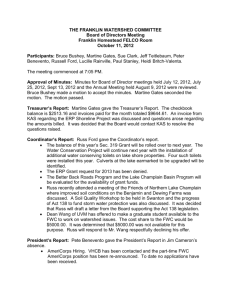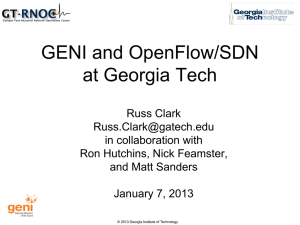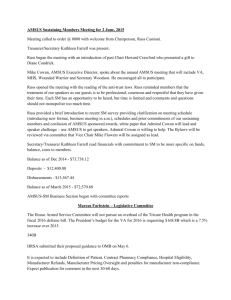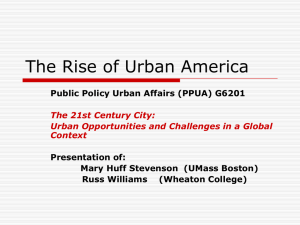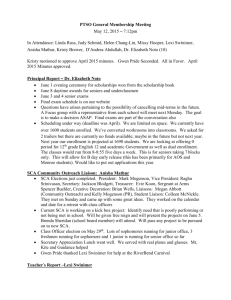Keywords
advertisement
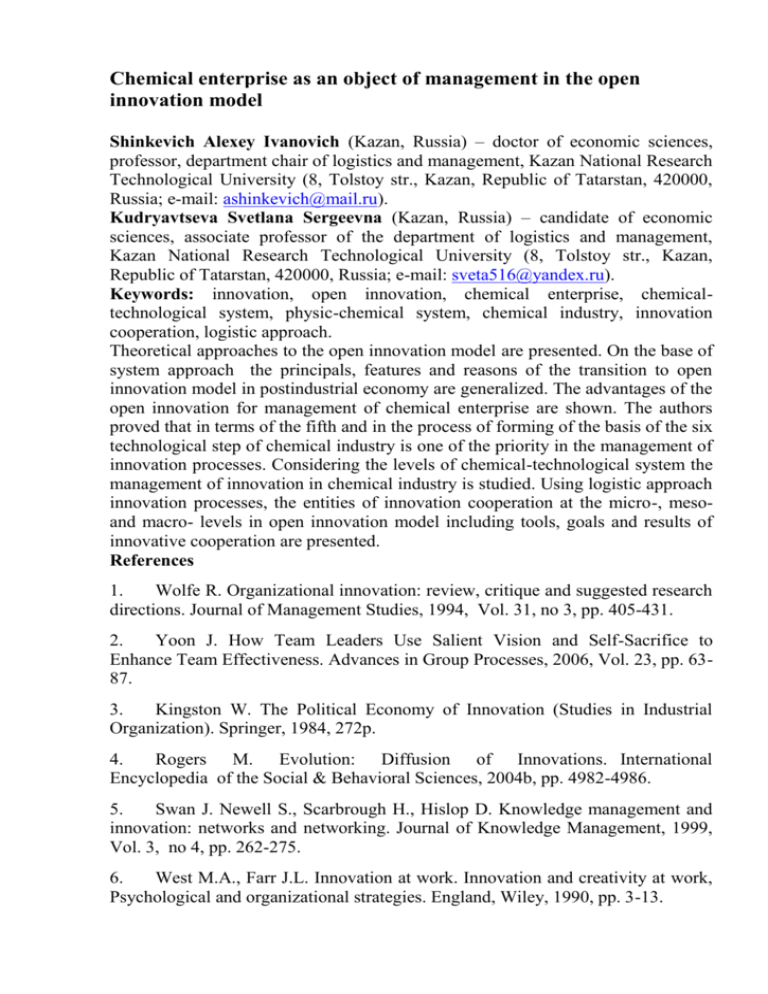
Сhemical enterprise as an object of management in the open innovation model Shinkevich Alexey Ivanovich (Kazan, Russia) – doctor of economic sciences, professor, department chair of logistics and management, Kazan National Research Technological University (8, Tolstoy str., Kazan, Republic of Tatarstan, 420000, Russia; e-mail: ashinkevich@mail.ru). Kudryavtseva Svetlana Sergeevna (Kazan, Russia) – candidate of economic sciences, associate professor of the department of logistics and management, Kazan National Research Technological University (8, Tolstoy str., Kazan, Republic of Tatarstan, 420000, Russia; e-mail: sveta516@yandex.ru). Keywords: innovation, open innovation, chemical enterprise, chemicaltechnological system, physic-chemical system, chemical industry, innovation cooperation, logistic approach. Theoretical approaches to the open innovation model are presented. On the base of system approach the principals, features and reasons of the transition to open innovation model in postindustrial economy are generalized. The advantages of the open innovation for management of chemical enterprise are shown. The authors proved that in terms of the fifth and in the process of forming of the basis of the six technological step of chemical industry is one of the priority in the management of innovation processes. Considering the levels of chemical-technological system the management of innovation in chemical industry is studied. Using logistic approach innovation processes, the entities of innovation cooperation at the micro-, mesoand macro- levels in оpen innovation model including tools, goals and results of innovative cooperation are presented. References 1. Wolfe R. Organizational innovation: review, critique and suggested research directions. Journal of Management Studies, 1994, Vol. 31, no 3, pp. 405-431. 2. Yoon J. How Team Leaders Use Salient Vision and Self-Sacrifice to Enhance Team Effectiveness. Advances in Group Processes, 2006, Vol. 23, pp. 6387. 3. Kingston W. The Political Economy of Innovation (Studies in Industrial Organization). Springer, 1984, 272p. 4. Rogers M. Evolution: Diffusion of Innovations. International Encyclopedia of the Social & Behavioral Sciences, 2004b, pp. 4982-4986. 5. Swan J. Newell S., Scarbrough H., Hislop D. Knowledge management and innovation: networks and networking. Journal of Knowledge Management, 1999, Vol. 3, no 4, pp. 262-275. 6. West M.A., Farr J.L. Innovation at work. Innovation and creativity at work, Psychological and organizational strategies. England, Wiley, 1990, pp. 3-13. 7. Gamidov G.S., Kolosov V.G., Osmanov N.O. Foundations of innovation. St. Petersburg, Politehnica [Polytechnic], 2000, 323p. (in Russ.). 8. Glaz’ev S.Y. Theory-term technical and economic development. Moskow, ValDar [ValDar], 1993, 310p. (in Russ.). 9. Yakovec Y.V. Epochal innovation of the 21st century. Moskow, Economica [Economics], 2004, 443p. (in Russ.). 10. Kafarov V.V., Meshalkin V.P. Analysis and synthesis of chemical processes. Moskow, Himiya [Chemistry], 1991, 432p. (in Russ.). 11. Kafarov V.V., Meshalkin V.P. Methods for assuring and optimizing of the reliability of chemical and petrochemical industries. Moskow: Himiya [Chemistry], 1987, 270p. (in Russ.). 12. Abramov A.A. Theoretical basis of physico-chemical modeling of selective flotation processes of non-ferrous metal. Cvetnie metally [Nonferrous metals], 2013, no 2, pp. 41-45 (in Russ.). 13. Drobot D.V., Nikishina E.E., Lebedev E.N., Petrakova O.V. Soft chemistry methods in the technology of obtaining functional materials on the basis of trace elements III, V-VIII groups. Cvetnie metally [Nonferrous metals], 2011, no 3, pp. 52-55 (in Russ.). 14. Larichkin F.D., Azim Ibrohim, Glushchenko Y.G., Novocelceva F.D., Alieva T.E. Methodical approaches to optimization complex processing of raw material. Cvetnie metally [Nonferrous metals], 2011, no 4, pp. 38-44 (in Russ.). 15. Chesbrough H. Open innovation: creating profitable technologies. Мoskow, Pokoleniye [Generation], 2007, 336p. (in Russ.). 16. Kudryavtseva S.S. Development of national innovation systems on the principles of open innovation. Economicheskiy vestnic Respubliki Tatarstan [Economic Bulletin of the Republic of Tatarstan], 2014, no 2, pp.41-46 (in Russ.). 17. Meshalkin V.P., Dovi V., Marsanich A. Principles of industrial logistics. Voskow-Genuya, RHTI im. D. I. Mendeleeva [D. Mendeleyev University of Chemical Technology of Russia], 2002, 722p. (in Russ.). 18. Shinkevich А.I., Shinkevich М.V. State and perspectives of innovation development of institutional and logistical systems of industry the Republic of Tatarstan. Каzan, Каzanskiy gosudarstvennyj tehnologicheskiy universitet [Kazan National Research Technological University], 2006, 252p. (in Russ.). 19. Meshalkin V.P. Kakatunova T.V. Information Systems of management of innovation in the regional industrial complex. Zhurnal pravovih i economicheskih issledovaniy [Journal of Legal and Economic Studies], 2011, no.4, pp. 191-193 (in Russ.). 20. Meshalkin V.P., Kakatunova T.V., Dli M.I. The impact of risk information on innovative activities in the regional industrial complex. Transportnoye delo Rossii [Russian transport business], 2011, no 4, pp. 56-59 (in Russ.). Influence of porosity layer of iron-potassium-cerium catalyst for dehydrogenation processes methylbutenes and gasification of carbonaceous deposits Lamberov Alexander Adol'fovich. Kazan (Volga) Federal University, Dr. Sc. Science prof. Department of Physical Chemistry, Chemical Institute. AM Butlerov, 420008, Kazan, ul. The Kremlin, 18. Tel .: (843) 231-53-46. e-mail: lamberov@list.ru Sapozhnikov Alexander Alekseivich Kazan (Volga) Federal University, engineer laboratory adsorption and catalytic processes, Department of Physical Chemistry, Chemical Institute. AM Butlerov, 420008, Kazan, ul. The Kremlin, 18. e-mail: franz90@mail.ru Gilmullin Rinat Raisovich candidate. Tech. Sciences, Head of Laboratory SEC. Tel.: (8555) 37-51-56 e-mail: GilmullinRiR@nknh.ru Gilmanov Khamit Khamisovich, .D., First Deputy General Director of PJSC "Nizhnekamskneftekhim" , the chief engineer. Tel.: (8555)37-58-77 Keywords: specific surface area, porosity of the catalyst layer, potassium and cerium promoted iron oxide catalyst for the dehydrogenation of methylbutene, gasification of The influence of particle size potassium and cerium promoted iron oxide catalyst on performance indicators of dehydrogenation methylbutenes process was investigated. It was shown that the catalyst has not developed internal surface, and a dehydrogenation reaction takes place in kinetic region. Dehydrogenation process defined porosity of the catalyst layer, which increases with decreasing pressure gap was found. This in turn affects the gasification reaction of carbonaceous deposits and the efficiency of dehydrogenation process. The optimal value of porosity (0.62; Dgranule = 3mm) was defind and recommendations for changing production technology potassium and cerium promoted iron oxide catalyst of dehydrogenation methylbutenes were issued. Pilot tests of the sample with the changed diameter pellets were carried out and increase in the yield of isoprene was recorded. References 1. Krylov O.V. Heterogeneous catalysis.; M: ICC called "Akademkniga" [Academkniga], 2004. pp. 679 (in Russ.). 2. Lamberov A.A., Gilmanov H.H., Dementieva E.V., & etc. The dehydrogenation catalysts based methylbutanol micaceous iron pigments 3. 4. 5. 6. 7. 8. 9. with different physico-chemical properties // Kinetics and catalysis. [Kinetics and catalysis]. 2005. no. 5 pp. 18-19 (in Russ.). Deyarow I.N., Malkovsky P.A., Deyarow I.I. Methods of investigation of heterogeneous catalysts. – Kazan. KNITU, 2002. pp. 191. (in Russ.). Muhlenhof I.P., Dobkina E.I., Deryugina V.I., Soroko V.E. Technology catalysts / under the edition Muhlenhof I.P. 3 publication, - P.: Chemistry, 1989. pp. 272. (in Russ.). Dementieva E.V. The method of regulation of ferritic phases in micaceous iron catalyst dehydrogenation in industrial synthesis: dis. … candidate of technical Sciences: 05.17.01 / E.V. Dementieva. - Kazan, 2009. – pp. 175. (in Russ.). Gozde D., Taichi W., Jale Y., Md. Azhar U. // Fuel Processing Technology. 2014. V.126.PP 276-283. Lamberov A.A. Gilmanov H.H., Dementieva E.V., Shatokhina E.V., Gilmullin R.R. // Catalysis in industry. 2007. no. 6. (in Russ.). Zborschik A.M. Abstract of lectures on discipline "Theory of metallurgical processes". - Donetsk: state higher educational institution "Donetsk national Technical University", 2008. – pp. 101. (in Russ.). Wei H., Zhijie Z., Fuchen W., Yifei W., Guangsuo Y. // Fuel. [Fuel] 2014. V.131.pp. 59-65. Degree of the catalyst surface utilization on the ceramic supports of different structure Bespalov Alexandr Valentinovich, professor of Department of General chemical technology at Russian Mendeleev University of Chemical Technology, Doctor of technical Sciences. Address:127299, Moscow, Vokzalnyi St. 8-2-158. Phone +7(499) 978-90-63. Gasparyan Mikael Davidovich, leading researcher of the Department of General chemical technology at Russian Mendeleev University of Chemical Technology, candidate of technical Sciences. Address: 117042, Moscow, uznobutovskaya St. 50-12. Phone +7 (499) 978-90-63. E-mail: migas56@yandex.ru Grunsky Vladimir Nikolaevich, head of Department of General chemical technology at Russian Mendeleev University of Chemical Technology, Doctor of technical Sciences. Address:125480, Moscow, Vilisa Latsisa St. 25-2-29. Phone +7(499) 978-90-63. E-mail:oxt2011@mail.ru Zolotukhin Sergey Egorovich, assistant professor of Department of General chemical technology at Russian Mendeleev University of Chemical Technology, candidate of technical Sciences. Address: 115470, Moscow, Sudostroitelnaya St. 1210. Phone +7(499) 978-90-63 Keywords: utilization of the inner surface, ceramic high porous cellular catalyst, ceramic honeycomb catalyst, sulfur dioxide. Results of calculation of the degree of use of the inner surface of catalysts on ceramic supports of different structure: in the form of pellets, Raschig rings, block honeycomb and cellular – are presented. As a test for the catalysts of different structure oxidation reaction of sulfur dioxide to sulfur trioxide is selected with the following assumptions: the concentration of oxygen in the catalytic layer is negligible, the diffusion coefficients of SO2 and SO3 are closed, in the equation of the kinetics of sulfur dioxide oxidation reaction rate depends on the concentration of only SO2. To assess the quantitative influence of internal diffusion on the reaction the model of Zeldovich-Thiele was used. The values of degree of useng of the inner surface of the catalysts with different structures depending on equivalent diameter and porosity are determined. References 1. Bespalov A.V., Grunsky V.N., Kozlov A.I., Tatarinova I.N., Vanchurin V.I. The hydraulic properties of regular and irregular structures and structures of HPCM for small velocities of liquid filtration. Khimicheskaya promyshlennost segodnya [The chemical industry today], 2005, no.3, pp. 9-14 (in Russ.). 2. Antsiferov V.N., Ovchinnikova V.I., Porozova S.E.,Fedorova I.V. Highly porous permeable cellular materials. Steklo i keramika [Glass and Ceramics], 1986, no. 9, pp. 19-20 (in Russ.). 3. Antsiferov V.N., Beklemyshev A.M., Gilev V.G. etc. Problems of powder materials. Part II. Highly porous permeable materials. Ekaterinburg: UrO RAN, 2002, 262 p. 4. Danchenko YU.V., Antsiferov V.N., Savakov D.I. Composite materials on the basis of net-cellular structures. FHOM, 1998, no. 2, pp. 84-89. 5. Peng Y., Richardson J.T. Properties of ceramic foam catalyst supports one dimensional and two-dimensional heat transfer correlations. Applied Catalysis: A General, 2004, no. 266, pp. 235-244. 6. Ignatenkova V.V., Bespalov A.V., Grunsky V.N. The calculation of the external surface of highly porous cellular carriers. Entsiklopediya inzhenera khimika [Encyclopedia of chemical engineer], 2011, no. 5, pp.37-39. (in Russ.). 7. Kulakov S.V. Simulation of the structure of highly porous cellular materials. Perspektivnye materialy [Advanced materials], 2000, no. 3, pp. 22-26. 8. Malinovskaya O.A., Beskov V.S., Slinko M.G. Modeling of catalytic processes on porous grains. Novosibirsk: Nauka, 1975, 264 p. 9. Beskov V.S. General chemical technology. Textbook for universities. М.: IKTs, «AKADEMKNIGA», 2005, 470 p. 10. Krylov O.V. Heterogeneous catalysis. М.: М.: IKTs, «AKADEMKNIGA», 2004, 679 p. 11. Boreskov G.K. Heterogeneous catalysis. М.: Nauka,1986, 304 p. 12. Bespalov A.V., Chechetkina E.M., Shinkovskaya E.YU. About the optimal diameter of the through channel in block of the honeycomb catalyst. Zhurnal prikladnoy khimii [Journal of applied chemistry], 1994, V. 67, no. 11. pp. 18971899 (in Russ.). 13. Fedorov A.A. Highly permeable porous catalysts. Synthesis and properties . Abstract of Doctoral dissertation. Ekaterinburg, 1994. 39 p. 14. Saulin D.V., Puzanov I.S., Ketov A.A., Ostrovsky S.V. The heat transfer in the layer block catalytic media. Zhurnal prikladnoy khimii [Journal of applied chemistry], 1998, V. 71, no. 2, pp. 276-282 (in Russ.). 15. Leonov A.I., Smorygo O.L., Romashko A.N. etc. Comparative evaluation of the properties of the carrier block cell and cellular structure from the point of view of use in the catalytic purification of gases. Kinetika i kataliz [Kinetics and catalysis], 1998, V. 39, no. 5, pp. 691-700 (in Russ.). Regeneration of lanthanum and chromium compounds synthesis from lanthanum chromite heaters Suponitsky Yuri L. Mendeleyev University of Chemical Technology of Russia (MUCTR), D.Sc., pensioner, Department of General and Inorganic Chemistry, e-mail: yury_chemist@rambler.ru Solovyov Gennady S. Mendeleyev University of Chemical Technology of Russia (MUCTR), Ph.D., Associate Professor, Department of recovery. Liashenko Svetlana E. Mendeleyev University of Chemical Technology of Russia (MUCTR), Ph.D., Associate Professor, Department of General and Inorganic Chemistry, SvetlanaLiashenko@yandex.ru Keywords: ceramic heaters, lanthanum chromite, electrolysis, lanthanum chromate, electrode. Lanthanum and chromium compounds synthesis was investigated using membrane diaphragm electrolysis method (as the anode we took foul depleted ceramic lanthanum chromite heaters). The principal possibility was proved for obtaining precipitated lanthanum compounds as lanthanum hydroxide and in its compositions with chromium - as lanthanum chromate in sodium chloride solutions under the temperature of 298К. It was found that by passing through the electrolytic cell the charge in 1 Faraday 9.3 g of ceramic lanthanum chromite heaters is being processed. Thus, it was proved that in NaCl solution with isolated and acidic anode space under the current density of 5A/dm2 it is possible to obtain separately powders of lanthanum hydroxides and lanthanum chromates. References 1. Komissarovа L.N., Pushkina G.Ya., Suponitskiy Yu.L., Shatskiy V.M., Znamenskaya A.S., Dolgikh V.A., Shakhno I.V., Pokrovskiy A.N., Savelieva M .V. Manuscript: Compounds of rare earth elements. Sulfates, selenates, tellurates, chromates. M .: Nauka [Science], 1986, 366 pp. (in Russ.). 2. Prshibil R. Manuscript: Analytical application of EDTA and related compounds. M .: Mir [World], 1975, 509 pp. (in Russ.). 3. Kolthgoff I.M., Stenger V.A. Manuscript: Volume analysis. M-L .: GHI, 1961. v.3, 250 pp. (in Russ.). 4. Tsyrenova S.B., Suponitskiy Yu.L., Karapet'yants M.H. Thermochemical properties of lanthanum chromates . Jurnal phisicheskoy chimyi [J. of phys. chem.], 1974,v. 48, p.2705. (in Russ.). 5. Smyshlyaev S.I. Physical-chemical investigations of metal hydroxides: Autoreferat dissertatsiy doc. chim. nauk [Author. dis. ... Doc. chem. Sciences], M., 1975, 18 pp. (in Russ.). Methodology selection of the method of removing water-soluble impurities from suspensions of pigments Leont'eva Albina I., Chair of Department «Chemistry and chemical technology», Tambov State Technical University; e-mail: htov@mail.tambov.ru Orekhov Vladimir S., associate Professor of Department «Chemistry and chemical technology», Tambov State Technical University; e-mail: htov@mail.tambov.ru Obraztsova Elena Yu., docent Tambov State Technical University; e-mail: htov@mail.tambov.ru Zarapina Irina V., associate Professor of Department «Chemistry and chemical technology», Tambov State Technical University; e-mail: htov@mail.tambov.ru Osetrov Aleksandr Yu., associate Professor of Department «Chemistry and chemical technology», Tambov State Technical University; e-mail: htov@mail.tambov.ru Keywords: suspension, pigment, repulping, decantation, water-soluble impurities, metal nanoparticles. On the basis of the analysis of results of removal of water-soluble impurities from pigments the classification of their suspensions allowing to choose an optimum method of washing out is offered. The engineering method of calculation of technological parameters of the processes of removal of water-soluble impurities by a repulping multiple-decanting of suspensions of a pigment yellow C with use of an aqueous dispersion of nanoparticles of metals is developed. The technique of washing out of a sediment of a pigment orange G on a filtering partition is offered at cyclic supply of wash liquid. It allows to define the amount of wash liquid necessary for achievement of the demanded concentration of water-soluble impurities into a final product, time of carrying out components of a cycle, quantity of cycles, concentration of water-soluble impurities in wash liquid and in a settling at the end of each cycle. Identification of the developed techniques is carried out and results of check of their adequacy to actual process are given in industrial plants. The divergence between design and experimental values was 10,4%. References 1. Hromov A.V., Smrchek V.A. Structure and properties of organic pigments. Lakokrasochnye materialy i ih primenenie [Coating materials and their application], 2008, no. 8, pp. 38-42. ( in Russ). 2. Orehov V.S., Leont'eva A.I. Manifestation of electrokinetic properties of suspensions of organic synthesis products during their separation on the filter septum. Fundamental'nye issledovanija [Fundamental research], 2012, no. 9 (4), pp. 937-942. (in Russ). 3. Vilson Djeniel Dzh. Fundamentals of offset printing. M.: PRINT-MEDIA centr, 2005. 4. Semchikov Ju.D. Macromolecular compounds: a textbook for high schools. М.: Academia, 2006. 5. Solomon D. G. Chemistry of organic binders. M.: Himija, 1971. 6. Leont'eva A.I., Orehov V.S., Subocheva M.Ju., Kolmakova M.A. The study of the kinetics of the process of removing water-soluble impurities from the dense rain on the filter septum. Himija i himicheskaja tehnologija [Chemistry and Chemical Engineering], 2013, Т. 56. No. 8, pp. 122-126. ( in Russ). 7. Kosterin D.R. Theoretical studies of the process of separation of suspensions in thin-ponds. Izvestija Samarskoj gosudarstvennoj sel'skohozjajstvennoj akademii [Proceedings of the Samara State Agricultural Academy], 2007, no. 3, pp. 177-179. (inRuss). 8. Dytnerskij Ju.I. Processes and devices of chemical technology. Theoretical fundamentals of chemical engineering. Hydro and thermal processes and devices. M.: Himija, 1995. Ch. 1. (inRuss). 9. Romankov P.G., Frolov V.F., Flisjuk O.M., Kurochkina M.I. Methods for calculating the processes and devices of chemical technology. SPb.: Himija, 1993. (inRuss). 10. Vasil'cov Je.Ja., Ushakov V.G. Apparatus for mixing liquid media: A Reference Guide. L.: Mashinostroenie. Leningr. otd-nie, 1979. (in Russ). 11. Nigmatulin R. I. The dynamics of multiphase media. M.: Nauka, 1987. 12. Kolmakova M.A. Improving the process of removing water-soluble impurities from the jaws of organic pigments by cyclic wash-blowing sludge: Dis. ... Cand. those. Sciences. Ivanovo, 2012. 13. Trufanov D.N. Desorption of sodium and chloride ions from the surface of the particles of the organic pigment in repulping-decantation: Author. dis. ... Cand. those. Sciences. Ivanovo, 2013. 14. Rudobashta S.P., Kartashov Je.M. Diffusion in chemical-technological processes. M.: Kolos, 2010. 15. Aksel'rud G.A. Mass transfer in the solid-liquid interface. L'vov: Izd. L'vov. un-ta, 1970. 16. Leont'eva A.I., Subocheva M.Ju., Orehov V.S. Improving the efficiency of washing pastes azopigments using structured water and nanomaterials. Vestnik Tambovskogo gosudarstvennogo tehnicheskogo universiteta [Bulletin of Tambov State Technical University], 2009, Т. 15, no. 3, pp. 581-588. 17. Leont'eva A.I., Subocheva M.Ju., Orehov V.S. The solvent to remove the sodium salts of azo pigments pastes. V mire nauchnyh otkrytij [In the world of scientific discoveries], 2012, no. 9.1(33), pp. 213-226. (in Russ). 18. Orehov V.S., Leont'eva A.I., Trufanov D.N. The destruction of the electrical double layer of particles azo pigment. Jelektronnyj nauchno-obrazovatel'nyj zhurnal «Inzhenernyj vestnik Dona» [Electronic scientific and educational journal "Engineering Gazette Don"], 2012, no. 4. (in Russ). 19. Leont'eva A.I., Kolmakova M.A., Orehov V.S. The use of cyclic-pulse mode washing pastes filtering equipment to improve the quality characteristics of pigments. Vestnik Tambovskogo gosudarstvennogo tehnicheskogo universiteta [Bulletin of Tambov State Technical University], 2009, Т. 15, no. 1, pp. 113-119. (in Russ). Surface-active properties of polysiloxane-polyoxyalkylene copolymers Petrogradskiy Artem V. LLC «Penta-91» Senior Process Engineer, Russia 109316, Moscow, P.O. Box 73,tel +7(495)730-05-30, e-mail:petrotem@yandex.ru Greshilova Elena Y., LLC «Penta-91» Senior Process Engineer, Russia 109316, Moscow, P.O. Box 73,tel +7(495)730-05-30, e-mail:proporola@mail.ru Marcuse Inessa Y. LLC «Penta-91» Chief Process Engineer, Russia 109316, Moscow, P.O. Box 73,tel +7(495)730-05-30, e-mail:Lady-markuze@yandex.ru Kopylov Viktor M. LLC «Penta-91» Doctor of Chemical Sciences Prof., Deputy Director for Science Russia 109316, Moscow, P.O. Box 73,tel +7(495)730-05-30, e-mail:vmkopylov@rambler.ru Travkin Aleksandr E. LLC «Penta-91» Lead Specialist, Russia 109316, Moscow, P.O. Box 73,tel +7(495)730-05-30, e-mail:travkin_07@mail Keywords: polysiloxane-polyoxyksialkylene, copolymer,wettability, pourability, surface tension, polydimethylsiloxane, surface energy spreading. The wetting ability of the graft polymethylsiloxan-polyoxyalkylene copolymers (PSPE) and their aqueous solutions on the steel, glass and polycarbonate surfaces was investigated. The wettability evaluation was determined by wetting angle and surface tension, the flowing work (energy) was calculated by W f = -F , where F mN/m ratio Harkins. PSPE like PMS have a very high flowability and for Wf approximately zero values. Like nonionic surfactants, addition of PSPE severalfold decrease the σ and Wf of aqueous solutions. Some of them exhibit the properties of superlatively with Wf ≈ 0. High wetting ability and low surface tension make them extremely promising compounds for use as an additive in aqueous polymeric compositions or as spreading agents, wetting, super wetting agents and emulsifiers. References 1. 2. 3. 4. Gruning B., Koerner G., Tenside Surfactants Deterg. 1989, 26, p.312. Vick S.C., Soap Cosmetic Chem. Spec. May 1984, p 36. Gould C., Spec. Chem. August 1991, p.354. Kleine K.D, Schaefer D., Lersch P., Tenside Surfactants Deterg 1994, 31.p.234. 5. Gradzielski M., Hoffmann H., Robisch P., Ulbricht W., Tenside Surfactants Deterg., 1990, 27, p,366. 6. Starch M., De Vrries C., Parfum. Kosme.1986, 67, p.148. 7. Fink H.F., Tenside Surfactants Deterg, 1991, 28, p.306. 8. Demes H., Gaudchau M., Burow R.F., Role of organosilicone surfactants, in enhancing the performance of inorganic fungicides. Pestic. Sci. 1993, 38, p.278-280. 9. Burow R.F., Penner D., Roggenbuck F.C., and Hill R.M., Relationshp of organosilicone adjuvant structure and phase behavior to activity enhancement of actifluorfen and glyphosate Proceedings of the Fourth International Symposium on Adjuvants for Agrochemicals, Melbourne, Australia, 1995 p.54-59. 10. Hill R.M. Silicone Surfactants. Surfactant science series 86. Marcel Dekker, New York, 1999, p.360. 11. Pat. DE № 2007002, C08L83/04.Verbesserung der standfestigkeit von bei raumtemperatur zu elastomerenhartendenorganopolysiloxanmassen. Improving The Stability Of Elastomers At Room Temperature To Curing Organopolysiloxane, Nitzsche, S, Hittmair, P; Kaiser, W; Wohlfarth, E, 1971. 12. Pat. SU № 514873, С08L8304. Elekroprovodyashaya pastoobrasnaya komposiziya. Severnyi V.V., Uklonskiy D.A., Varlamova N.V., Velichko N.V., Bull. №19, 1976. 13. Pat. SU № 512853, В22С9/04; С04B35/00. Suspenziya dlja izgotovlenija keramicheskih form. Ivanov V.N., Chulkova A.D., Uklonskiy D.A., Lysenko L.S., Bull. №17,1976. 14. Pat. SU № 512853, C08L83/04; С08K5/54. Komposizija na osnove organosiliconovoy zhidkosti. Severnyi V.V., Uklonskiy D.A., Budko T.I., Bull. №34,1977. 15. Klaus D., Chem. Eng., 1974, V.81, № 23, p.321. 16. Owen M.J., in Silicon-Based Polymer Sciense (J. M. Zeigler and F.W.G. Fearon, eds.), American Cemical Society, Washington, DC, 1990, p.707. 17.Jang M.S., Bieon J.H., Ku M., Son H.G., Jung Y.M., Jang J.H., Min Y.G., Park S.H., Park Y.T.; Syntesis of Poly(dimethylsiloxane)-graft-Poly(ethyleneoxide) by Hydrosilation and their Properties, ISOS XVII BERLIN 2014 THE 17 th international Symposium on Silicon Cheistry.p.237. 18. Pat. US № 4777277, C07F7/08, C07F7/10. Organosiliconsulphosuccinates. Colas A., Renauld F.,1988. 19. Pat. US № 5700351, D21H17/14, D21H19/44, D21H21/12. Antifoams based on oil-in-water emulsions for the paper industry. Schuhmacher R., DralleVoss G., Oppenlaender K., Wegner B., Hohmann A., BASF AG, 1997. 20. Alexandridis P., Lidman B. Amphiphilic Blok Copolymers: Self-Assembly and Applications, Elsevier, Amsterdam, 1999, p257. 21. Kosaric N. Biosurfactants, Surfactant Science Series, 48, Marcel Dekker, New York, 1993. 22. Porter M.R. Handbook of Surfactants, Blackie & Sons, London, 1991. Determination of mass transfer coefficients from bubbles in the liquid and the efficiency of the process in the turbulent regime Laptev Anatoly Grigorievich - FGBOU VPO "Kazan state energy University, Dr technology. Sciences, Professor, head of Department "Technology of water and fuel, e-mail: tvt_kgeu@mail.ru, tel. +7(843)5194253, 420066, RT, Kazan, street Krasnoselskaya D. 51. Lapteva Elena Anatolevna- FGBOU VPO "Kazan state energy University, Kida t. Sciences, associate Professor of the Department of Industrial heat power engineering and heat supply systems", e-mail: tvt_kgeu@mail.ru, tel. +7(843)5194255, 420066, RT, Kazan, street Krasnoselskaya D. 51. Keywords: gas bubbles, turbulence, mass transfer, gas content, bypass, the efficiency of mass transfer. Using the concept of pseudo-laminar boundary layer considered applying of the equation based on the model of the diffusion boundary layer Levich, to calculate the mass transfer from the bubbles with different modes of motion. The main parameter of the equation is the shear stress at the interface of the bubble and the dimensionless thickness of the viscous sublayer. The expressions for the shear stress on the surface of the bubbles with the free movement and in the turbulent cocurrent with the liquid in the channels with elements of intensification (ring rolling and chaotic nozzle) are obtained. The prospects of application of turbulent flow mixer with random packing for mass transfer processes with gas-liquid medium are shown. The results of the calculation of mass transfer efficiency in removing dissolved carbon dioxide, from water are given. References 1. The study of diffusion boundary layers by the method of holographic interferometry / Diakonov, N. B, Sosnowski, L. P. Klinov, etc. / / Dokl. THE USSR ACADEMY OF SCIENCES.-1982.-T. 264.-No. 4.-P. 905-908. (in Russ) 2. Klinova L. P., Sosnovsky N. B., Diakonov Mathematical modeling of the process of dissolution of solid particles in devices with agitators // Mass transfer processes and apparatuses of chemical technology: Intercollege. thematic. scientific collection. Tr. -Kazan: Kazan state technological University, 1987.-P. 114-125. (in Russ) 3. Voynov N. And., Zhukova O. P., Loukacheva O. N. The mass transfer in gas-liquid flow bioreactor// Biotechnology.2014, no.1.with.62-66. (in Russ) 4. Kawase Y. Mathematical models for design of biorectors applications of Kolmogoroff’s theory of isotropic turbulence / Y. Kawase, M.Moo-Young // Chem. Eng. J. – 1990. – V. 43, № 5. – P. 1319–1341. 5. Braginsky, L. N. Mixing in liquid media: physical principles and engineering methods of calculation / L. N. Braginsky, V. I. Bogachev, V. M. Barabash. - Leningrad: Khimiya, 1984. (in Russ) 6. Brownstein B. I. Hydrodynamics. Mass - and heat transfer in a column apparatus / B. I. Bronshtein, V. vol. - L.: Chemistry, 1988. 7. . Laptev A. G. boundary layer Model and calculation of heat and mass transfer processes. - Kazan: Publishing house of Kazans. University press, 2007. 500 p. (in Russ) 8. Laptev, A. G., Clearings T. M., Todorovska O. G. mass transfer Model by solvent extraction in a turbulent co-current // hfis, T. 88. No. 1. 2015. 203-s. (in Russ) 9. The R. I. Nigmatulin, Dynamics of multiphase media / R. I. Nigmatulin. M.: Nauka, 1987. -S. (in Russ) 10. Sokolov, V. N. Gas-liquid reactors / V. N. Sokolov, I. V. Domansky. Russ, 1976. -P.216. (in Russ) 11. Laptev, A. G., E. A. Laptev Model of turbulence in the liquid phase barbatano layer/ international journal of applied and fundamental research, 2013. No. 12. -P. 18-22. (in Russ) 12. Belov, I. V., Punctures E. V. the Study of mass transfer in the system of gas bubbles and liquid /journal of Applied mechanics and technical physics, 1969, No. 1, pp. 116-121.Laptev, E. A., Clearings T. M. Mathematical model and calculation of heat and mass transfer characteristics. Edited by A. G. Laptev. - Kazan: Fatherland, 2013 - s. (in Russ) 13. Kagan, A. M., Laptev A. G., Pushnov A. S., Clearings M. I. Contact packings of industrial heat and mass exchange devices. Edited by A. G. Laptev Kazan: Fatherland, 2013, - 454 p. (in Russ) 14. Kagan, A. M., Laptev A. G., Pushnov A. S., Clearings M. I. Contact packings of industrial heat and mass exchange devices. Edited by A. G. Laptev Kazan: Fatherland, 2013, - 454 p. (in Russ) 15. Ramm V. M., " gas Absorption. Ed. 2nd, the reprocessing. and additional M., "Chemistry", 1976. -S. (in Russ) 16. Kogan, V. B. Theoretical foundations of the model processes of chemical technology, V. B. Kogan. - Leningrad: Khimiya, 1977.-S. (in Russ) 17. Laptev, A. G., Clearings T. M., Todorovska og Model eddy viscosity and mixing in the channels and nozzle flow faucets / / " ZH. T. 86. Issue 7. 2013. S. 1112-1121. (in Russ)

